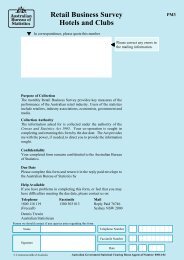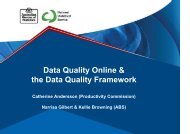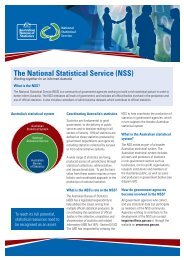SAE Manual Sections 1 to 4_1 (May 06).pdf - National Statistical ...
SAE Manual Sections 1 to 4_1 (May 06).pdf - National Statistical ...
SAE Manual Sections 1 to 4_1 (May 06).pdf - National Statistical ...
You also want an ePaper? Increase the reach of your titles
YUMPU automatically turns print PDFs into web optimized ePapers that Google loves.
A Guide <strong>to</strong> Small Area Estimation - Version 1.1 05/05/20<strong>06</strong><br />
1.1 What are Small Area Estimates?<br />
1. Introduction<br />
Most ABS surveys are designed <strong>to</strong> provide statistically reliable, design based estimates<br />
only at the national and/or state/terri<strong>to</strong>ry geographic levels. The sheer practical<br />
difficulties and cost of implementing and conducting sample surveys that would provide<br />
reliable estimates at levels finer than state/terri<strong>to</strong>ry are generally prohibitive, both in<br />
terms of the increased sample size required and the added burden on providers of<br />
survey data (respondents). For purposes of this manual, small area estimation refers<br />
<strong>to</strong> methods of producing sufficiently reliable estimates for geographic areas that are <strong>to</strong>o<br />
fine <strong>to</strong> obtain with precision, using direct survey estimation methods. By direct<br />
estimation we mean classical design based survey estimation methods (Saei and<br />
Chambers, 2003) that utilise only the sample units contained in each small area. Small<br />
area estimation methods are used <strong>to</strong> overcome the problem of small samples sizes <strong>to</strong><br />
produce small area estimates that improve upon the quality of direct survey estimates<br />
obtained from the sample in each small area. The more sophisticated of these methods<br />
work by taking advantage of various relationships in the data, and involve, either<br />
implicitly or explicitly, a statistical model 1 <strong>to</strong> describe these relationships. (See <strong>Sections</strong><br />
4.1 & 4.2 for further discussion).<br />
Although conceptually similar, small domain estimates refers <strong>to</strong> those disaggregated<br />
<strong>to</strong> fine classifica<strong>to</strong>ry levels, such as by socioeconomic status, income, labour force status<br />
or industry. It is important <strong>to</strong> note that we have not undertaken any empirical study for<br />
small domain estimation methods for this manual, although intuitively we would expect<br />
that most techniques covered in this manual would still apply. The empirical analysis of<br />
this manual is based on knowledge and experience derived from only one empirical<br />
study, this being a study of the incidence of disability in Australia. This study uses data<br />
from the Survey of Disability, Ageing and Carers (SDAC) (see ABS (2003) for more<br />
details).<br />
1 A statistical model is a mathematical representation of the relationship we assume <strong>to</strong> exist<br />
between the variable we are interested in predicting (known as the response or dependent<br />
variable) and other associated variables (known as the auxiliary, explana<strong>to</strong>ry or independent<br />
variable). A model is then fitted <strong>to</strong> data that contains observed values for both the<br />
dependent variable and the auxiliary variables for each unit. The fitting process produces<br />
estimates of the model parameters such as intercepts and slopes. The unit here may be a<br />
person, a business or a small area itself, depending upon the level at which we wish <strong>to</strong> fit the<br />
model. The model also includes one or more error terms <strong>to</strong> describe the degree of<br />
s<strong>to</strong>chastic or random variation with which predicted values for the response variable deviate<br />
from the observed values.<br />
Australian Bureau of Statistics 5








